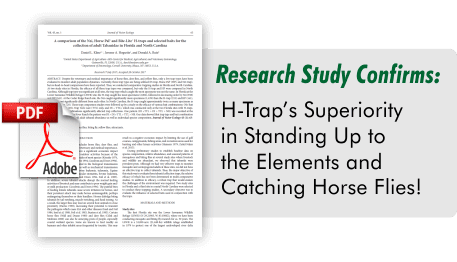The news is out! The Bite-Lite H-Trap Professional Horse Fly Trap has been vetted by researchers as the “best monitoring trap” for catching tabanids during studies conducted in Florida and North Carolina in 2014 and 2015, respectively. Researchers also found the H-Trap the most wind stable compared to other commercial and government surveillance traps used in the study.
The research took place at two locations in Cedar Key, Florida, including the Lower Suwannee Wildlife Refuge. The North Carolina study took place in the city of Beaufort. The researchers conducting the tests in Florida were Daniel L. Kline and Jerome A. Hogsette of the US Department of Agriculture- ARS-Center for Medical Agriculture and Veterinary Entomology; in North Carolina, Donald A. Ruts from the Department of Entomology at Cornell University conducted the testing.
Besides the H-Trap, the Florida tests utilized two other commercial horse fly traps: the Horse Pal (HP) and a Nzi government surveillance trap which was modified for this study. In North Carolina, only the Horse Pal and H-Trap were compared. In North Carolina, the H-Trap caught nearly double the specimens of tabanids (1458 compared to 720) during the four month study from June through September. At the Lower Suwannee Wildlife Refuge, the H-Trap caught the most specimens (2006 compared to the Nzi 938 and the Horse Pal 541).
“Overall, the H-trap caught the most specimens and the greatest number of species. This trap was considerably easier to service by just removing/lifting off the entire collection container. Conversely, the collection container of the HP [Horse Pal] trap often came apart while removing it, and that could have resulted in losing part of the collection if care was not taken. During these trials, we found that the H-trap was more stable during very windy conditions (>30 mph). Although the experiments reported herein were not affected, there were several times between experiments that the HP and Nzi-SB were blown over by very windy conditions, but H-traps remained intact. This observation was further supported during ongoing studies when tropical storm Hermine (sustained winds of 39-73 mph with wind gusts of 74-110 mph) ravaged Cedar Key causing severe wind damage to homes and businesses but did no damage to seven H-traps that had been left in the field during the storm.most effective and sturdiest horse fly trap out there among other commercial and government surveillance traps on the market.”
The study can be read in the Journal of Vector Ecology, Vol. 43 (1): 63-70, 2018. Click here or below to learn about more about the study entitled “A comparison of the Nzi, Horse Pal, and Bite-Lite H-traps and selected baits for the collection of adult Tabindae in Florida and North Carolina.”


